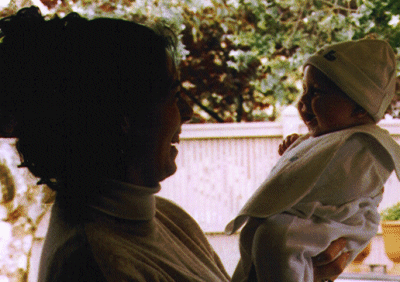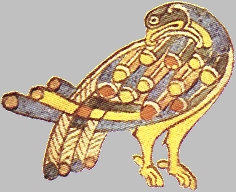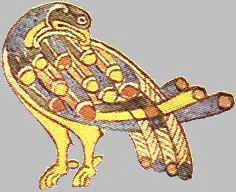(c) Did the Finnerty clan feature in any significant way in
Irish history?
- The Finnertys first seem to appear in Irish history books as the direct
descendants of Conway, who was the oldest son of King Muireadach Muilleathan. King
Muireadach was head of several septs in the Province of Connacht, and he died in 701 A.D.
On account of their association with the oldest son of
Muireadach, the Finnertys were the most senior family in the group as far as privileges
went.
|
The book shown above (written by Richard M. Finnerty)
is on display at Donamon Castle.
Seniority with regard to practical political power in the
"Síol Muireadach" (Seed of Muireadach) group went to the descendants of a
younger son of Muireadach: these descendants had the name of "Ó
Conchobhair" - or "O' Connor", or "Connor", as the name much
later became know in the English language.
Two members of the O' Connor family later found themselves well
known places in Irish history books.
Top of
this page
Toirdelbach Ua Conchobhair is
considered by many historians to have been one of the most outstanding High Kings that
Ireland ever had; and his son "Ruaidrí Ó Conchobhair" had the unique
distinction of being the very last High King of Ireland. Ruaidrí died in
1198. The remains of both he and his father now rest in the ruins of the Cathedral at
the ancient ecclesiastical site of Clonmacnoise - which, very appropriately it seems, is
located right in the heart of Ireland, and literally just a
stone's throw from Ireland's largest river: The Shannon.
During Ruaidrí's reign, a string of problems with a subordinate
and apparently "difficult" provincial king (Diarmait Mac Murchada, King of
Leinster), led directly to the Anglo Norman Invasion of Ireland: which in turn quickly
gave rise to huge upheavals in Irish history - by far the biggest since the arrival of St
Patrick 700 years or so earlier.
A big part of the problem with Diarmait was that he got himself
involved in a very publicly conducted abduction controversy: because of a love affair
between himself and the wife (Dervorgilla) of another provincial king (Tiernán O' Rourke
of Breifne). Both of these men were battle hardened Celtic warrior kings, and it is not
too difficult to imagine how they went about settling their differences.
There was a lot of trouble, and matters were not helped by the
fact that a number of close observers on both sides believed the "abduction" was
all very cleverly engineered by Dervorgilla herself. Under great pressure "to do
something", High King Ruaidrí eventually decided to banish Diarmait from Ireland (a
punishment not all that uncommon in those days, and one which a son of King Brian Boru -
Donnchad, who died in Rome in 1064 - had earlier accepted). However, Diarmait could not,
or would not, accept this judgement: and quickly went to see King Henry ll of England (who
was really a Norman, and whose first language was French). Although King Henry was very
interested in Diarmait's invitation to invade Ireland (at the small cost to him of
reinstating Diarmait), he was too busy taking over other places elsewhere to get directly
involved himself. Nevertheless, he gave Diarmait a very supportive letter which later
enabled him to enlist the services of a Norman military leader in Wales named Strongbow.
Shortly afterwards the Anglo Norman Invasion of Ireland got under way. This was a pivotal
moment in Irish history, as the invasion was to have massive consequences for Ireland's
future.
Top of
this page
With their flair for political guile, the Norman invaders
behaved differently from many others in that they were happy from the very beginning to
mix socially with the indigenous Celtic people of Ireland. To set the pattern (which in
all probability was the first step of a "divide and rule" policy), part
of the agreement between Diarmait Mac Murchada and Strongbow was that Diarmuit's eldest
daughter (Aoífe) would become Strongbow's wife. (Marriages of this kind, combined with
superior Norman military technology - much of which the Irish Celts had never experienced
before - appear to have been the main factors in the rapid Anglo Norman take-over of
Ireland.)
Several others followed the lead set by Diarmait and Strongbow
regarding marriage arrangements - but not all. The Finnertys appear to have been
amongst those who choose not to participate, and consequently they had most of their lands
taken from them shortly after the Norman invasion. Without delay, the Normans set about
building large, well fortified castles in the places they took over - making it extremely
difficult for the dispossessed to ever regain control of the land which once was theirs.
(Strong castles of the type in question - many still standing in places like Donamon,
Athenry, etc., would have been completely new to the Celts of the time in Ireland.)
As might be expected, deep divisions arose amongst Irish Celts
regarding the matter of (as some would see it) fraternising with the Anglo Norman enemy.
In one bizarre incident (around 1307), it seems the "last Finnerty" in Donamon
(already living in reduced circumstances), was murdered by his own wife: as part of a
political deal involving marriage to a Norman Knight who wanted to get hold of the Clann
Conway title (which he later took). The lady in question is now known in Irish history as:
Nuala na Miodoige
(Nuala-of-the-Dagger).
We have seen mention of a John Finnerty who was Bishop of Elphin
around 1354, and after that the name Finnerty appears (to us) to have faded away from the
history books for several centuries.
Following the severe social turbulence connected with the Anglo
Norman invasion, it seems that many of the dispossessed members of the Finnerty family of
Donamon moved away from the area and set up homes in several different parts of Ireland,
including various places in Counties Galway (e.g. New Inn, which is just one hour's drive
or so from Donamon), and Kerry. We have seen references to a printer named Peter Finnerty
from Loughrea (1766 to 1822) - who was imprisoned for refusing to give information about
the United Irishmen. Many went overseas of course: Galway born John Frederick Finnerty
founded "The Chicago Citizen" we understand, while his son Michael J. Finnerty
(who died in 1908) was a United States soldier and politician.
Finally, and possibly a little irrelevant, we know of a young
Finnerty descendant born in 1996 in Australia (whose name does not appear in any
history books). Although his parents knew nothing at the time about the ancient link of
long ago between the two families, they named him "Connor": and he is the first
great grandson of the late W.T. Finnerty (of New Inn, Co. Galway). Was the choice of name
coincidence? Or might it have been prompted by hidden memories of ancient events:
transmitted in a genetic form which can survive many sequences of life and death? As far
as we know, it is entirely possible that such information (or indeed any
information which nature chooses) can be passed on through the chemical coding
processes on which genetics depends.

Siobhán Tara Finnerty and Connor
(Melbourne 1996)
| Top of this page | Turoe
Stone |
More
about Irish family names
| Home  | |
 Links | Links |
Last major update: April 22nd 2000 (Easter Sunday)

VISITOR |

|
NUMBER |
Internet: http://homepage.eircom.net/~williamfinnerty/
Email: wfinnerty@eircom.net
Copyright © 2000 by William Patrick
Finnerty (New Inn). All rights reserved.
|
|

